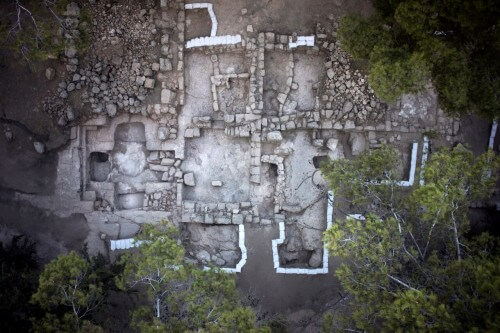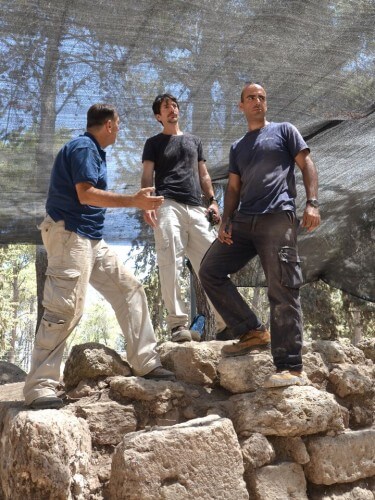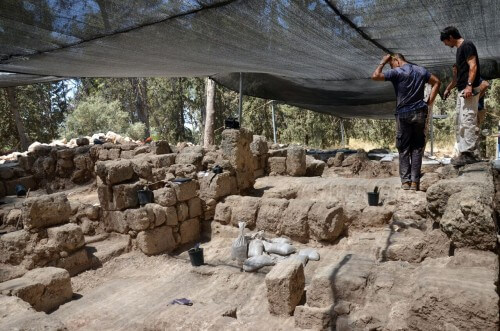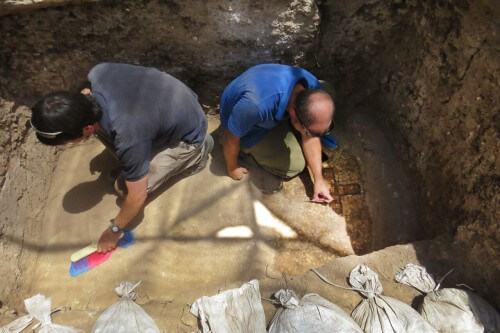The Antiquities Authority calls on the public to donate, volunteer and participate in the discovery


In recent weeks, the Antiquities Authority, residents of the Modi'in area and teenagers conducted an extraordinary archaeological dig in search of the true location of the Maccabees' tomb.
According to the sources, the Maccabees - Mattithyahu the Hasmonean and his five sons, from the ancient city of Modi'in, led the rebellion against the Greek government, and were responsible for purifying the Second Temple from impurity. The archaeological excavation requested to check if there is truth in the legends and stories woven around the site of the Gardi ruins, which is located a short distance from the city of Modi'in, and whose name is associated with the tomb of the Maccabees.
The tomb of the Maccabees was described in two ancient books about two thousand years old: the Book of Maccabees and the Antiquities of the Jews, written by Joseph ben Matityahu. The tomb was described as an impressive, tall structure, surrounded by columns, overlooking the sea, made of fine stones, and covered in a sort of pyramid.
The proximity of the Gardi ruins to the Arab village of Al-Midia, and the similarity between the village's name and ancient intelligence, attracted educated and curious archaeologists to it about 150 years ago. Some of them documented the site with drawings and paintings, and some of them even managed to excavate it. These revealed an impressive tomb structure supported by enormous art, which held huge stone slabs, and above them, apparently, there was a second floor. Magnificent burial mounds were discovered at the bottom of the building. The excitement was great, and the first researchers even issued written statements: "Indeed, there is no room for doubt: I found the tomb of the Maccabees and the excavation that I uncovered held the ashes of Matthias"; "The ruins of the tomb certainly correspond to the tomb of the Maccabees as it is described in the sources."

The enthusiasm was cooled by a French archaeologist named Charles Clermont-Gano. His excavations at the site revealed mosaics on the floor of the burial mounds, with a cross decoration on them. Following this, he firmly stated that the purpose of the building is unknown, and its character is Christian. He added that "it is possible that this structure was built by the Christians to commemorate the burial place of the Maccabean saints, since these were supreme saints in the eyes of Christianity. It is not impossible that in the future you will find unequivocal evidence pointing to the site as the burial place of the Maccabees." Since that archaeologist's report, the site has been abandoned and remains in ruins.
Recently, the Antiquities Authority decided, in an unusual step, to go on a search for the tomb of the Maccabees, with the aim of cracking the mystery of the place once and for all, with the help of modern research tools. Such a discovery is undoubtedly of first-class national and research significance.
In the last few weeks, the magnificent tomb structure was located, and it was excavated a second time with the help of many residents of Modi'in and the communities of the Modi'in region. They were swept up in the adventure and contributed to the excavation, voluntarily, with their time and energy, and became an integral part of the professional team.

According to Amit Ram and Dan Shahar, the managers of the excavation on behalf of the Antiquities Authority: "There is no doubt that the structure that was uncovered is unusual. The descriptions from 150 years ago were revealed here in front of our eyes, we discovered the magnificent burial mounds, tremendous art that apparently held a second floor, an entrance courtyard leading to the tomb and other ancillary buildings. To our disappointment, the structure that our predecessors saw was looted, and its stones were taken to build the surrounding settlements, but still, the sight of the place is impressive and inspires imagination. The archaeological evidence we have at this stage is still not sufficient to establish that this is the burial place of the Maccabees. If what we have uncovered is not the tomb of the Maccabees itself, then there is a high probability that this is the site where early Christianity identified the royal tomb estate, and therefore, perhaps, erected the structure. It seems that past assumptions cannot be dismissed outright, but a lot of digging and work is still needed in order to unequivocally verify this assumption, and the puzzle remains - the search for the elusive Maccabees' tomb continues."
The Antiquities Authority financed the excavation of the tomb from its budget, and now additional resources are needed for the extraction of the area, in the hope of getting an answer to the riddle of the Maccabees.
To volunteer or to support the excavation through a donation, click here
The Hashemnaim series, by the historian Dr. Yehiam Sorek, exclusive to the Hidan website
- Everything we wanted to know about the Hasmoneans and were ashamed to ask - 1: We prayed to this hero?!
- The Hasmoneans Chapter 2: Will? I did not know!
- The Hasmoneans, Chapter Three: The conflagration also fell on Shimon
- History of the Hasmoneans - Chapter XNUMX - Yohanan Hyrcanus I
- The Hasmoneans Chapter XNUMX - Peace, Lord King
- The Hasmoneans Chapter XNUMX: Yanai - Blain from this and executioner from this
- The Hasmoneans - Chapter XNUMX: Finally, a queen. inclusive? manipulative? Or simply from a lack of political backbone?
- The Hasmoneans, part nine: between corruption and murder. Did the feud between the brothers bring an end to the kingdom of the House of Hasmoneans?
- The Hasmoneans Chapter XNUMX: Antigonus the Hasmonean king of the Parthian bayonets. deterioration?!

5 תגובות
Yossi, there are some problems with your response
1) In science there are no absolutely unequivocal proofs, science usually focuses on refuting other theories and less on developing new ones.
2) A cross in the cemetery can say several things:
A) It is possible that the tomb was renovated by Christians as described in the article
b) The cross became the symbol of Christianity only in the second century AD, and became popular only in the third century, and as you claimed there is no unequivocal proof that it was not used as a decoration at that time.
Joseph
Click here to
I agree with everything you wrote.. Correct and rational responses. Beautiful
Sometimes there is not enough DNA left for reconstruction. If there are bones there they will try to carry out genetic and carbon dating. It takes a few years.
Today there are DNA tests, which will accurately indicate the relatives of those buried.
In this place, they are looking for antiques that will fit the legends
In any other science if there is no clear proof then it is not. Here:
A. There is no proof at all
B. There is a cross in the cemetery. This implies that I am a Christian.
third. Administrative science by publishing in an academic journal first, not on TV news.
In XNUMX a casual hypothesis is expressed that these are the tombs of the Maccabees. Apparently none of the graves are like this, neither the previous one nor this one.